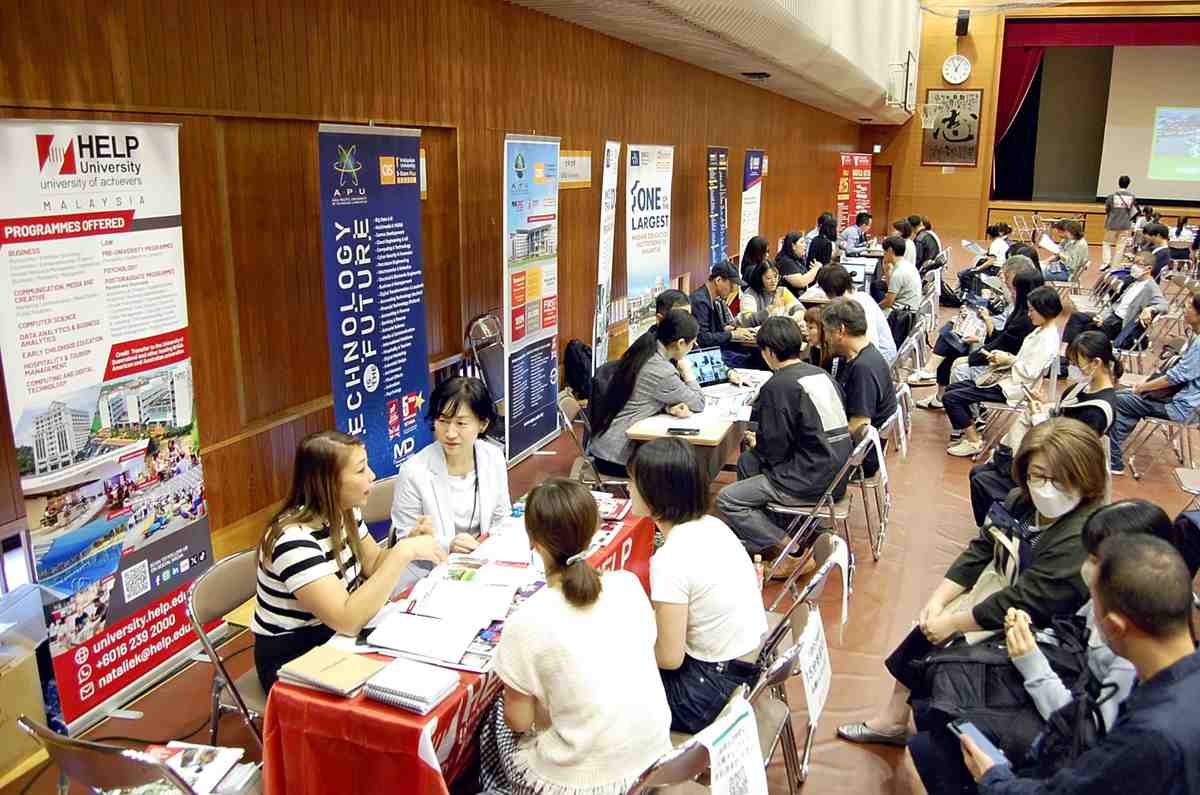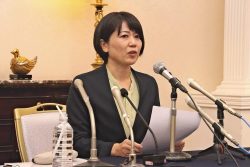Malaysia Growing in Popularity as Destination for Studying Abroad; British-style Education Available at Low Cost

People visit the Malaysia study abroad fair in Chuo Ward, Osaka, in October.
7:00 JST, November 18, 2024
Malaysia is becoming a popular destination among high school students who aim to study abroad after graduation.
Compared to Europe or North America, where the weak yen has skyrocketed cost of living and tuition fees, Malaysia offers significantly lower costs. It also offers an education system modeled on that of the United Kingdom, which would help students smoothly transfer to universities overseas, especially ones in the United Kingdom.
On Oct.12, 11 universities and language schools from Malaysia opened booths at the Malaysia study abroad fair held at Otemon Gakuin Otemae Senior High School in Chuo Ward, Osaka.
“We want to have more Japanese students for diversity, to create a balance. We want to have a community there,” said Jiehan Wong, a faculty member from IMU University, which is strong in the medical field.
About 250 participants were seen enthusiastically asking questions such as about the level of English required.
Taught in English
According to Tokyo-based Global Hub Japan Ltd., the event organizer that supports students studying in Malaysia, annual tuition fees in Europe and North America cost between ¥2.5 million and ¥7 million, but they are between ¥500,000 and ¥1.5 million in Malaysia. Living and housing costs are also about one-third of the cost. Studying abroad for three to four years would be between ¥15 million and ¥40 million in the West, compared to ¥4 million to ¥9 million in Malaysia.
University education is modeled on that of the United Kingdom, Malaysia’s former colonial ruler, with three years of undergraduate study and classes conducted in English. There are also many branch campuses of U.K. or Australian universities in Malaysia, and students with a certain level of achievement can transfer to the main campus.
The number of high school students and graduates who have gone on to Malaysian universities through Global Hub has more than doubled in recent years, though it was below 100 per year until 2019.
“Interacting with students of various ethnicities has changed my values,” said a 23-year-old Akari Hayashi who studied at Monash University’s Malaysia campus and currently works for a foreign-affiliated company. “The hurdles of cost and language ability are relatively low, so if you decide to go, you can do it.”
According to the Education, Culture, Sports, Science and Technology Ministry’s survey, 1,424 Japanese high school students who graduated in March 2022 went on to study at a foreign university. By country or region, Malaysia was the sixth most popular destination, coming in after the United States, Taiwan, South Korea, Canada and the United Kingdom, with 73 students.
Affiliated schools
The official language in Malaysia is Malay, and English is not the first language. While the United States or other English-speaking countries are a good option for those wanting to improve their English, perspectives have been shifting.
Sophia University Specially Appointed Prof. Takehiko Kariya, who also is a professor emeritus at University of Oxford, said, “Studying abroad is no longer just for the top students, but has become a strong option for anyone wanting to gain overseas experience.”
Kariya, who is well-versed in overseas educational conditions, said the stereotype that “English is something you learn from native speakers” is starting to break down.
Another factor behind the popularity is that the political situation is relatively stable in Malaysia among Asian countries, and several universities in the country have started rising in world university rankings.
Momoyama Gakuin high school, or St. Andrew’s School, in Abeno Ward, Osaka, has recommended study at partner universities overseas since last year to its students, designating six schools in Malaysia alongside six schools in the United Kingdom, Ireland and the United States. More than 100 people attended an information session this spring, with many of their inquiries being about Malaysia.
Expanding into Malaysia

Students at the University of Tsukuba Malaysia attend a class in English.
A Japanese university has also branched out in Malaysia.
The University of Tsukuba opened a branch in Malaysia in September and established its School of Transdisciplinary Science and Design. Classes are mainly conducted in Japanese and English, and 13 students — seven Malaysians and six Japanese — are studying there.
The school is aimed at developing international human resources and raising the university’s international reputation.
“Western universities are using their branch schools as a gateway to attract talented people to their home countries,” said Prof. Maki Tsujimura, dean of the school. “We hope to be able to stand on a par with top overseas universities by taking this opportunity to establish a branch school.”
"Society" POPULAR ARTICLE
-

M4.9 Earthquake Hits Tokyo, Neighboring Prefectures
-

M7.5 Earthquake Hits Northern Japan; Tsunami Waves Observed in Hokkaido, Aomori and Iwate Prefectures
-

Tsukiji Market Urges Tourists to Avoid Visiting in Year-End
-

Beloved Cat Stationmaster Nitama in Wakayama Pref. Passes Away at 15
-

M5.7 Earthquake Hits Japan’s Kumamoto Pref., Measuring Upper 5 Intensity, No Tsunami Expected
JN ACCESS RANKING
-

Japan’s Hopes for Seafood Exports Shot Down in China Spat
-

Keidanren Chairman Yoshinobu Tsutsui Visits Kashiwazaki-Kariwa Nuclear Power Plant; Inspects New Emergency Safety System
-

Japan to Charge Foreigners More for Residence Permits, Looking to Align with Western Countries
-

Imports of Rare Earths from China Facing Delays, May Be Caused by Deterioration of Japan-China Relations
-

Japan Exports Rise in October as Slump in U.S. Sales Eases






















